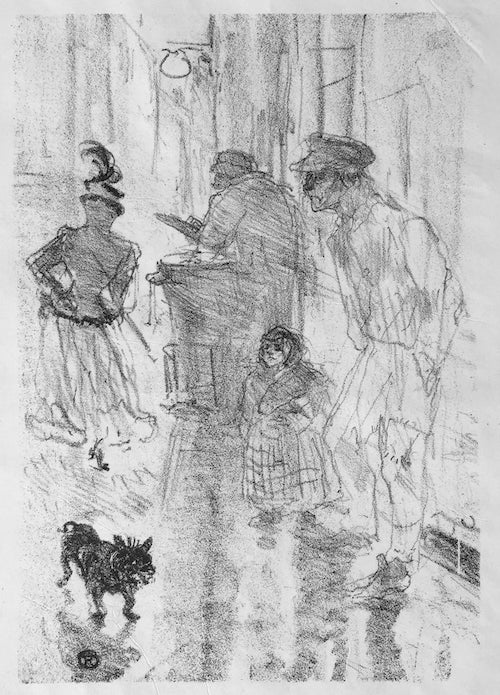
The drawing seen here may not be the most faithful representation of a French Bulldog, but the artist is certainly among the most famous who ever put paint to paper to render the breed. Entitled, “Bouboule,” the painting of the dog belonging to Madame Palmyre was portrayed by Henri de Toulouse-Lautrec in 1897, and it was by no means the only time Toulouse-Lautrec illustrated the breed.

Henri de Toulouse-Lautrec The Chestnut Vendor (Le marchand de marrons)- 1897
As students of art history know, Toulouse-Lautrec was famous for his depiction of the bohemian nightlife of late-19th-century Paris, particularly the Moulin Rouge and other cabarets in the Montmartre district of Paris. His subjects were often “ladies of the night,” and while the very people who used the services of these women often slandered them, Toulouse-Lautrec simply painted what he saw without judgement.
He had unique access.
Today, it’s suspected that Toulouse-Lautrec was afflicted with Pycnodysostosis, a genetic lysosomal storage disease of the bone. In the late 19th century, Toulouse-Lautrec was simply regarded as a freak with an adult-sized torso, but child-sized legs. Prostitutes accepted Lautrec as a fellow outcast, and allowed him full access to wander around, painting and sketching what he saw, and what he saw often included French Bulldogs – very popular with the “belles du nuit.”
The breed soon became the companion dog of the working class, but Parisian bohemians eager to shock society with a breed favored by hookers and peddlers adopted the dogs for themselves, and from there, Frenchies became darlings of the artsy set across Europe. It didn’t take long for the breed to jump into fashionable parlors – and the laps of well heeled dames mariées and dames non mariées, alike.
Mistinguette would own a Frenchie (at one time, the highest-paid female entertainer in the world), and so did King Edward VII with his dog, “Peter.” Photos from this time also show the Russian Royal family posing with their French Bulldogs, dogs said to have been imported from France. One of them was “Ortipo,” a Frenchie belonging to Nicholas II’s daughter, Tatyana. He had been a gift presented to Tatyana in 1914 by an officer recovering in a hospital that the grand duchess visited. Sadly, Ortipo was killed by guards outside the Romanov house annoyed with the dog’s barking.
Thankfully, the end of Ortipo was not the end of the breed. Its affectionate and easy-going manner has made it a favorite across the world, and the most popular breed in New York, San Francisco, and Miami.
